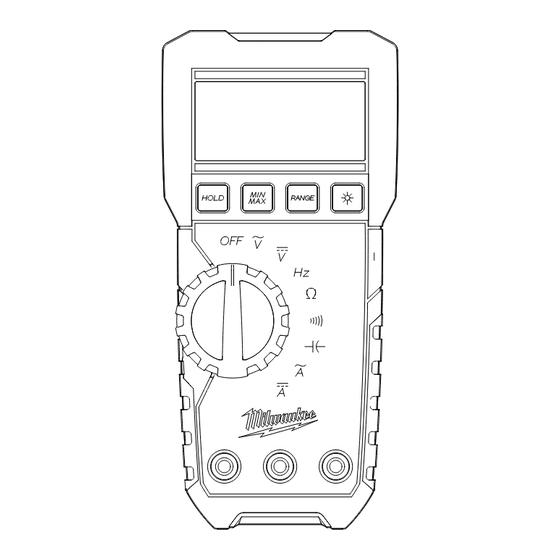
Milwaukee 2217-20 Operator's Manual
True rms multimeter (dmm)
Hide thumbs
Also See for 2217-20:
- Repair service instructions (21 pages) ,
- Operator's manual (16 pages) ,
- Operator's manual (25 pages)
Advertisement
Cat. No.
2217-20
TRUE RMS MULTIMETER (DMM)
TO REDUCE THE RISK OF INJURY, USER MUST READ AND UNDERSTAND OPERATOR'S
MANUAL.
OPERATOR'S MANUAL
IMPORTANT SAFETY INSTRUCTIONS
WARNING
READ ALL SAFETY WARNINGS AND INSTRUCTIONS.
follow the warnings and instructions may result in electric shock, fi re and/or serious
injury, as well as instrument damage and/or damage to the equipment being tested. Save these
instructions - This operator's manual contains important safety and operating instructions
for the MILWAUKEE True RMS Multimeters (DMM). Before using, read this operator's manual
and all labels on the True RMS Multimeters.
DANGER
Never make measurement on a circuit in which voltage over 600V rms exists. Use only leads
rated 600V CATIII or better.
Do not apply more than the rated voltage, as marked on the DMM, between terminals or be-
tween any terminal and earth ground.
Do not attempt a current measurement when the open voltage is above the fuse protection
rating. Suspected open circuit voltage can be checked with voltage function.
Do not use the DMM to measure voltages in circuits that could be damaged by the DMM's low
input impedance in Lo-Z Function. Impedance is approximately 4KΩ.
Do not attempt to make measurement in the presence of fl ammable gases. Otherwise, the use
of the instrument may cause sparking, which can lead to an explosion.
Never attempt to use the instrument if its surface or your hand is wet.
Do not exceed the maximum allowable input of any measuring range.
Only test on unenergized circuits unless absolutely necessary.
Check tool functionality on a known circuit fi rst. Never assume tool is working. Assume circuits
are live until they can be proven de-energized.
Never open the Battery cover during a measurement.
Do not ground yourself while measuring. Avoid body contact with earthed or grounded sur-
faces such as pipes, radiators, ranges and refrigerators.
This instrument is to be used only in its intended applications or conditions. Otherwise, the instru-
ment's safety functions may not work, resulting in serious personal injury and instrument damage.
To reduce the risk of injury from shock and arc blasts, always wear personal protective
equipment where live conductors are exposed.
WARNING
Never attempt to make measurement if any abnormal conditions, such as broken case and
exposed metal parts are found on the instrument.
Comply with local and national safety requirements when working in hazardous locations.
Keep fi ngers behind the guards and away from test lead tips during measurements.
Do not rotate the Rotary Dial while the test leads are being connected.
Never attempt a voltage measurement with the test lead inserted into the A input terminal.
Verify proper operation on a known source before use or taking action as a result of the in-
dication of the instrument.
Do not install substitute parts, replace fuse or make any modifi cation to the instrument. For
repair or re-calibration, return the tool to a factory Service/Sales Support Branch or authorized
service station.
Do not try to replace the batteries if the surface of the instrument is wet.
Disconnect all the cords and cables from the object under test and power off the instrument
before opening the Battery Cover for Battery replacement.
This tool is designed to be powered by 2-AA batteries properly inserted into the MILWAUKEE
True RMS Multimeters. Do not attempt to use with any other voltage or power supply.
Install battery according to polarity (+ and –) diagrams.
Do not leave batteries within the reach of children.
Do not mix new and used batteries. Do not mix brands (or types within brands) of batteries.
Properly dispose of used batteries.
Do not incinerate or dismantle batteries.
Under abusive conditions, liquid may be ejected from the battery, avoid contact. If contact
accidentally occurs, fl ush with water. If liquid contacts eyes, additionally seek medical help.
Liquid ejected from the battery may cause irritation or burns.
Failure to
Advertisement
Table of Contents

Subscribe to Our Youtube Channel
Summary of Contents for Milwaukee 2217-20
- Page 1 Disconnect all the cords and cables from the object under test and power off the instrument before opening the Battery Cover for Battery replacement. This tool is designed to be powered by 2-AA batteries properly inserted into the MILWAUKEE True RMS Multimeters. Do not attempt to use with any other voltage or power supply.
-
Page 2: General Specifications
2 AA, NEDA 15 A,IEC LR6 Risk of electric shock Battery Life Approx. 26 Hours all lights on Fuse 600V AC/DC, 10A Fast-acting (Milwaukee p/n 22-89-0305) Safety Compliances EN61010-1, UL 61010-1, UL 61010-031 (Probes), EN61010-031 Earth (Probes), IEC/EN 61010-1 2nd Edition for measurement... -
Page 3: Operation
WARNING Only use Milwaukee test WARNING To avoid an electrical hazard, Voltage AC leads with the MILWAUKEE DMM. Inspect test 60.00V/600.0V 0.01V/0.1V ±(2.0% + 3 dgt) (500~1000Hz) turn the Rotary Dial to OFF and disconnect the leads for continuity before each use. Do not test leads before replacing batteries. - Page 4 Frequency Capacitance DC Voltage Temperature 1. Set the Dial to position. 1. Set the Dial to position. 1. Set the Dial to position. 2. Connect the red test lead to the 2. Use the Range button to se- DANGER To avoid electrical shock: 2.
-
Page 5: Maintenance
ACCESSORIES WARNING Always remove batteries before changing or removing accessories. Only use accessories specifi cally recommended for this tool. Others may be hazardous. Rely on premium power tools by Milwaukee if you’re looking for quality and efficiency.




Need help?
Do you have a question about the 2217-20 and is the answer not in the manual?
Questions and answers